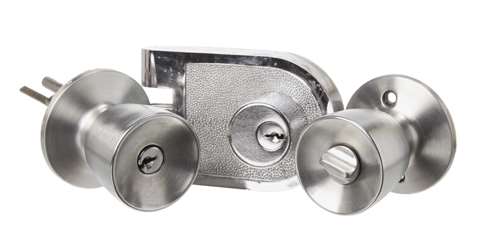Your Cart is Empty
Categories
Industry
Security Breach? How to Change the Lock On a Door

Have you ever misplaced your house keys, or had any other reason to believe that the security of your home may have been breached? The truth of the matter is that unless you’re the very first person to live at your address, you really can’t be sure how many copies of your house keys might exist. From feeling unsafe in your home, to leaving your keys somewhere or having your purse stolen, at some point changing your locks may be a necessary step to take.
Here are the basic steps you’ll need to change the lock on a door:
1. Find out what brand of lock you have – This information can usually be found somewhere on the latch, or on the keys that came with your lockset. While you may not need to have an exact replacement of your previous door lock, knowing your lock’s manufacturer will give you a good idea of the type of the lock, fit and functionality you’ll require for your new lock.
2. Make sure to measure the size of the latch or deadbolt – A common measurement for contemporary locksets is usually either 2-3/4 inch or 2-3/8 inch in length. Simply measure the distance from the edge of the door to the the center of your doorknob. Most new locksets have bolts or latches that can accommodate both sizes.
3. If possible, remove the interior doorknob first – Make sure to release the springs holding the doorknob in position. Once this happens, removing the doorknob should be fairly easy. Depending how the doorknob is designed, you might have to remove the decorative cover first before you’re able to access the springs on the doorknob.
4. Remove the screws that bind the interior section of the lock and the exterior section – Once these screws have been taken out of the way, you can pull each half of the lock away from the door.
5. Remove the latch plate and strike plate – It may be possible for you to keep the old latch plate and strike plate if the new lock you purchased is very similar. You will have to make a careful comparison beforehand to determine if the new plates are basically the same; if so, just keep the old plates in place, because removing and replacing the old screws will weaken their position in the door, or possibly strip the screw holes.
6. Install the new latch by placing it in the recess – If it fits snugly into the recess, you won’t need to tighten the screws until the rest of the elements of the lockset have been installed.
7. When you install your new lockset, make sure that you’re putting the keyed parts on the outside – Be sure that the strike plate is in alignment with the new lock. Use your key to test the locking mechanism before tightening everything down; you want to make sure that it’s working before you finish the installation!
8. Now tighten all remaining screws and check to make sure everything’s functioning properly – You’re all set!
While the steps above will generally work just fine, there are definitely times when changing out the locks can get a little more complicated. Stubborn or ill-fitting parts, stripped screws, outdated locksets, etc., can really put a damper on what would normally be a relatively simple process.
Want to know how you can keep from having to change your locks ever again? Purchasing and installing keyless locks on your doors will eliminate any future need to change the locks on your home because no keys required for entry means no keys that can potentially be misplaced or stolen. All you’d need to do is punch in a quick security code on the lock’s keypad (like on the Lockey M210, for example), and you’re in the house in a flash.
Additionally, any time you leave the house, you won’t have to worry about keeping up with keys; as long as you have your security code, you’re good to go, with no worries about your house keys falling into the wrong hands. So skip all the headaches associated with traditional locks and keys–upgrade your home security and make your life a lot easier by going keyless.
Browse by Category
© 2025 GoKeyless. All rights reserved. Privacy Policy. Terms of Use. Powered by Brandography.



 Over 5 Million Locks Sold
Over 5 Million Locks Sold Trusted Since 2003
Trusted Since 2003 Help
Help
